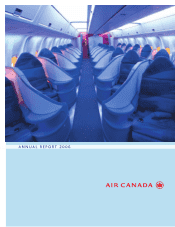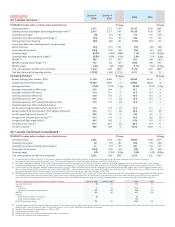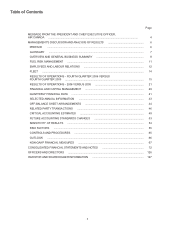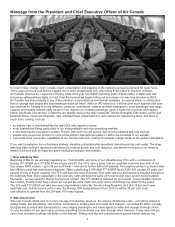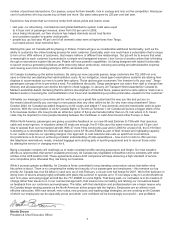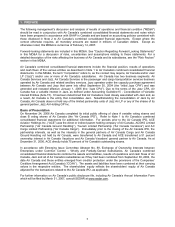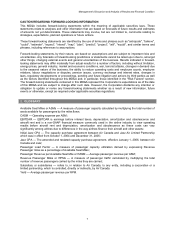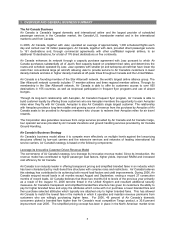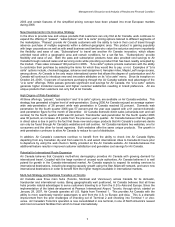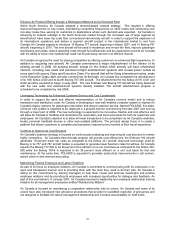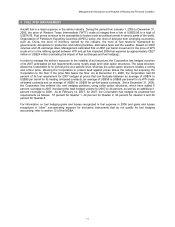Air Canada 2006 Annual Report Download - page 10
Download and view the complete annual report
Please find page 10 of the 2006 Air Canada annual report below. You can navigate through the pages in the report by either clicking on the pages listed below, or by using the keyword search tool below to find specific information within the annual report.
Enhance its Product Offering through a Redesigned Network and a Renewed Fleet
Within North America, Air Canada adopted a demand-based network strategy. This resulted in offering
improved frequencies on key routes, maintaining competitive frequencies on other routes and introducing new
non-stop routes thus serving its customers to destinations where such demand was expected. Air Canada is
achieving its network redesign in the North American market through the increased use of large regional jet
aircraft which have lower trip costs than conventional narrow-body aircraft. In order to support the expansion of
its international operations and deliver a superior aircraft product in the international market to and from
Canada, Air Canada expects to introduce 19 Boeing 777 aircraft, beginning in March 2007, and 14 Boeing 787
aircraft, beginning in 2010. The new aircraft will be used to modernize and re-size the fleet, improve passenger
load factors and yields, reduce operating costs through fuel efficiencies and are expected to provide Air Canada
with the ability to serve new markets that could not be previously served in an efficient manner.
Air Canada recognizes the need for staying competitive by offering customers an enhanced flight experience. In
addition to acquiring new aircraft, Air Canada commenced a major refurbishment of the interior of its
existing aircraft in 2006. All existing aircraft, except for the Airbus A340 aircraft, will have refurbished
interiors, including new seats and personal in-flight entertainment systems and in-seat power outlets at
every seat in Economy Class and Executive Class. For aircraft that will be flying international routes, seats
in the Executive Class cabin will also convert into lie-flat beds. Air Canada has completed the refurbishment
of its 16th Airbus A320 and its fourth Boeing 767-300 aircraft. The refurbishment for the Airbus A319, A321 and
A330 aircraft is expected to begin in early 2007. The new Embraer and Boeing 777 aircraft are being delivered
with the new seats and entertainment systems already installed. The aircraft refurbishment program is
scheduled to be completed by mid-2008.
Leveraging Technology for Enhanced Customer Service and Cost Containment
In order to support the rapid and efficient implementation of Air Canada's revenue model and to reduce
transaction and distribution costs, Air Canada is developing a new web-enabled computer system to replace Air
Canada's legacy systems for passenger reservation and airport customer service. Named POLARIS, this state-
of-the-art new system is expected to be deployed in a phased manner commencing from late 2007 and running
through a major part of 2008. The new technology is expected to be innovative, flexible and cost effective and
will allow Air Canada to facilitate and streamline the reservation and travel processes for both its customers and
employees. Air Canada's objective is to allow all travel transactions to be completed via Air Canada's websites,
kiosks, personal handheld devices or other web-enabled platforms. The principal design focus is to create a
platform that allows customers to complete any transaction required at any moment of their travel experience.
Continue to Improve its Cost Structure
Air Canada's business strategy is focused on continuously evaluating and improving its cost structure to remain
highly competitive. Air Canada’s fleet renewal program will provide cost efficiencies; the Embraer 190 aircraft
generates 18 percent lower trip costs as compared to the Airbus 321 aircraft. Improved technology used by
Boeing in its 777 and 787 aircraft bodies is expected to generate lower fuel-burn rates for airlines. Air Canada
expects the Boeing 777-300 to be 26 percent more efficient on a unit cost basis as compared to the Airbus 340-
500 while the Boeing 787-8 is expected to be 30 percent more efficient on a unit cost basis for fuel and
maintenance. At the same time, POLARIS is expected to generate productivity improvements in call centers,
airport check-in and revenue accounting.
Maintaining Positive Employee and Labour Relations
As part of its focus on employee relations, Air Canada is committed to communicating with its employees in an
open and transparent manner and to providing them with the tools they need to do their jobs. Air Canada is
acting on this commitment by training managers to help them create and promote meaningful and positive
employee relations and by providing its employees with increased opportunities for dialogue and feedback. As
part of this commitment, in January 2007, Air Canada launched a leadership and employee relationship training
initiative for all management employees entitled “Relationship Matters”.
Air Canada is focused on maintaining a cooperative relationship with its unions. Air Canada and some of its
unions have also introduced new grievance procedures that provide for expedited resolution of grievances and
are designed to facilitate the labour-management relationship and increase accountability on both sides.
10

